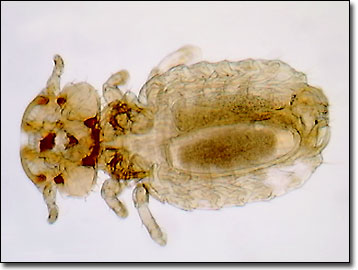Brightfield Digital Image Gallery
Canine Biting Louse (Trichodectes canis)
In the wingless insect suborder of chewing lice (Mallophaga), Trichodectes canis is the louse species that most commonly feeds on domestic dogs and other canids such as coyotes, wolves, and foxes, which may come into contact with dogs. Unlike ticks and other parasites, the 2,800 species of biting lice described worldwide are very host-specific. The dog louse, or canine biting louse, is about 1.5 millimeters in length with a dorsoventrally flattened body and a broad, flat head. As representatives of the Isonocera group, chewing lice extend their highly visible trisegmented antennae laterally. Each of the six legs (three pairs) is armed with a strong claw for holding onto the host canid, even in the face of frantic biting and scratching.

T. canis should not be confused with the canine sucking louse, Linognathus setosus, which features a short, blunt head, and seeks blood meals on dogs and their relatives. Rather than needle-like mouthparts that pierce skin, chewing lice, as their names imply, have large, opposing mandibles used to feed on hair fragments, nearby skin, and blood. Symbiotic bacteria found in specialized mycetocytes in the insect's fat reserves are required for digestion, and when individuals are deprived of these bacteria, they perish in a few days.
With a life cycle that takes about three to four weeks, and includes incomplete metamorphosis (hemimetabolous), canine biting lice can be found anywhere on the dog's body. While rare on healthy animals, poorly nourished dogs may have heavy infestations, adding to their troubles. In addition to causing severe itching and loss of sleep, Trichodectes canis can act as the intermediate host for the dog tapeworm, Dipylidium caninum. In the case of Alaskan wolf packs infected by human pets, extensive hair loss in sub-zero temperatures creates metabolic demands that reduce survival rates.
Females lay up to 100 eggs or nits. The nits of the canine biting louse are protected by an operculum and are cemented to the base of the dog's hairs. When the eggs hatch, the operculum is lost and the larva emerges through an opening. Since the entire 20-day louse life cycle is spent on the hosts, louse control primarily involves isolating and treating infested dogs with insecticides. There is no need to treat indoor carpets or backyard soils or vegetation as required with other canine pests such as fleas and ticks. Often adding additional Vitamin B to the dog's diet helps fight these infestations.
Contributing Authors
Cynthia D. Kelly, Thomas J. Fellers and Michael W. Davidson - National High Magnetic Field Laboratory, 1800 East Paul Dirac Dr., The Florida State University, Tallahassee, Florida, 32310.
BACK TO THE BRIGHTFIELD IMAGE GALLERY
BACK TO THE DIGITAL IMAGE GALLERIES
Questions or comments? Send us an email.
© 1995-2025 by Michael W. Davidson and The Florida State University. All Rights Reserved. No images, graphics, software, scripts, or applets may be reproduced or used in any manner without permission from the copyright holders. Use of this website means you agree to all of the Legal Terms and Conditions set forth by the owners.
This website is maintained by our
Graphics & Web Programming Team
in collaboration with Optical Microscopy at the
National High Magnetic Field Laboratory.
Last Modification Friday, Nov 13, 2015 at 01:19 PM
Access Count Since September 17, 2002: 46700
Visit the website of our partner in introductory microscopy education:
|
|
